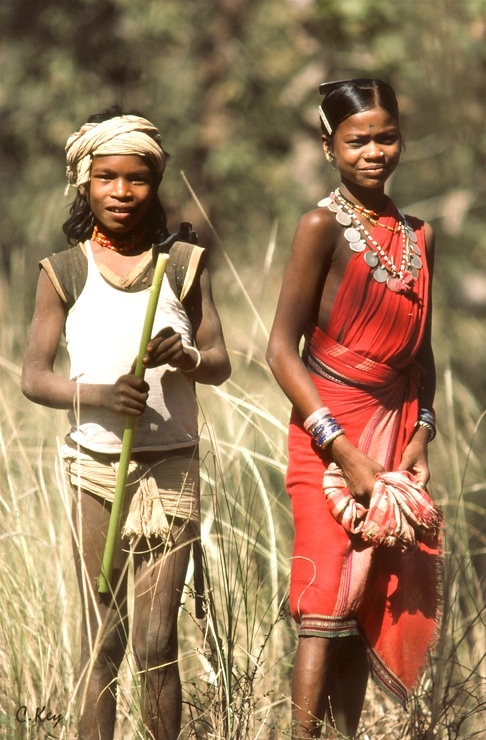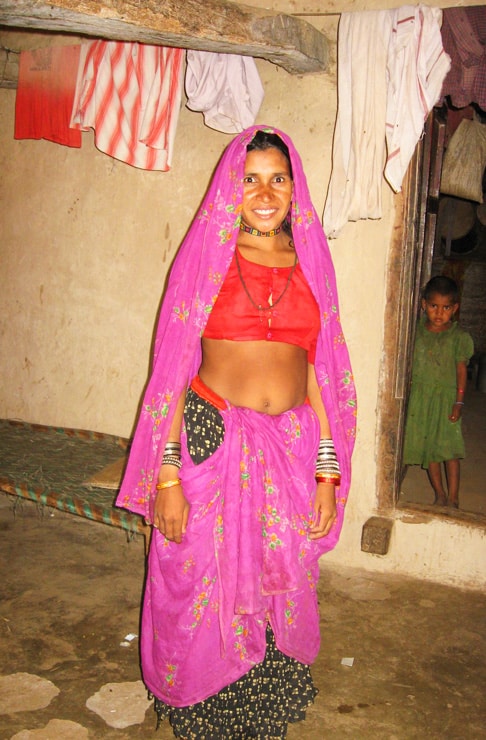Two communities that are geographically far apart, and may not have had the means to readily influence the other in olden days share a striking resemblance in the ways their young men and women can choose their lovers. The Muria tribe from Chhattisgarh is a part of the Gond people, and the Garasia tribe of Rajasthan is a part of the Rajput people who married Bhil tribal women.
Note: The intention of this story is not to romantically dramatize the two communities, but to share the beauty of the diversity in thoughts and living practices that India has.

The forests and villages of the Bastar region in Chhattisgarh are alive with colorful tribes, weekly farmer markets called ‘Haat’ (हाट), and an interesting culture where young men and women are encouraged to live-in and choose their own partners.
The parents teach their children as young as 10-years old in the matters of community service and give them the freedom to explore friendships, romantic relationships, and sexuality as they grow up. The physical boundaries imposed between men and women that modern society fights to break are thin in the Muria community. By this, we not only mean physical intimacy, but also a playful, joyous, and overall healthy interaction.
Life isn’t all fun and frolic though. The men wake up before sunrise to go to the fields and the women manage the entire household. But when the evening arrives, the young wear traditional jewelry and spend time with good music and dances in the community dormitory called ‘The Ghotul’ (घोटुल).
Many stories may romanticize a Ghotul as just a place for drinking, dancing, and sexual relationships. But nothing could be far from the truth. Every Ghotul (or a community dormitory) normally has two leaders, a male ‘Sirdar’ (सरदार), and a female ‘Belosa’ (बेलोसा) who are appointed by the community itself.
Ghotul is a social institution where young boys called ‘Chelik’ (चेलिक) and girls called ‘Motiari’ (मोटियारी) learn about cleanliness, sweeping, cooking, hard work, and discipline. They also learn about community service, respecting the elders, and taking pride in their own appearance and culture. In fact, all the important social functions, festivals, and marriage and death ceremonies happen in the Ghotul.

Evenings in a Ghotul involve the married men playing drums and the younger ones singing, dancing, eating, and consuming the ‘Sulphi’, a local liquor made of the ‘Mahua’ (महुआ) flower in a leaf cup called the ‘Sirhana’ (सिरिहना). As the events progress, the young boys and girls begin to pair up and move inside the dormitory with mutual consent. They may spend the rest of the night just talking or engaging in sexual activity.
Every Ghotul culture may vary slightly. While some encourage monogamous relationships, others discourage emotional attachment and penalize the couple for spending more than a few nights together. At times, the Sirdar and Belosa pair up the couples.
The Sirdar and Belosa also make sure that there are no preferences based on the physical beauty or popularity of a person. This is a community’s way of letting things take their own course without interference or objection. If the boy or the girl feels so, they can choose other partners unless they find someone they want to get married to.
While the decision is mutual, the Motiari has a choice to change her decision and refuse the Chelik. No one can force or coerce the other into the marriage.
Once a couple chooses to marry, the ‘Chelik’ puts a white flower in the hair of the ‘Motiari’ as a message for the village.
The talks for marriage proceed with the boy’s family paying a mutually agreed sum of money to the girl’s family. If the boy’s family does not have enough, the community sometimes helps the family monetarily or the boy works till the time he can pay the agreed sum to get married.
If the couple decides not to marry and back out after declaring it to their families, they may return to the Ghotul to choose other partners. But that only happens if they agree to some form of punishment for giving each other up.



The Garasia community lives in the western front of India in Rajasthan and Gujarat. Unlike the Muria people, the Garasia don’t have a community dormitory. But the women have complete freedom to choose their spouse and a couple living together or having children outside of wedlock is common.
Central Rajasthan, primarily the areas around Ghanerao and Pali district which is known as the leopard country, are hot and dry. The farming is mostly from rain-fed water. The Garasia people are not one of the richest as compared to their neighboring tribes such as the Rabari and Bishnoi. But they hold large pieces of land which they cultivate.
The community is ahead of its time especially in the matters of love and marriage. The couples can elope at the annual Gaur fair. Once they return, they can choose to live together without marriage as a pre-requisite. Since the women have a higher stature in the community, the boy has to pay a mutually agreed sum of money to the girl’s family to marry her.
The couple can choose to marry or stay without it for life. If during this time, the woman wants to live with another man she can do so. But the man she chooses to live with has to pay a higher sum of money to her current partner.
The stories of Garasia and Muria tribes remind of the stone carvings and wall murals from ancient India that openly depict sexuality. Khajuraho’s group of temples, though very well known, are not the only ones in India with erotic engravings.
India’s remote villages and old monuments are littered with temples, ruins, ancient universities, and cave paintings that depict a liberal sexual attitude in everyday life. We met Dr. Arun K. Sharma, an ex-archaeologist with the Archeological Survey of India (ASI) who gave the reason behind this.
He has studied the history of central India right from the time when Buddhism dominated the region to the medieval age. He explains in the video why Indian temples had bold stone carvings showing sexual activities. Our ancient communities had a very different concept of marriage, romantic relationships, and sexuality.


With the increasing influence of the modern education system, the media, and the internet, there is an increasing tussle within the Garasia and the Muria community about the traditional practices. Youth who are educated outside of the Ghotul education system, grow up believing that pre-marital sexual relationships are immoral. The native community however says that the non-tribal society has an incompatible viewpoint and their beliefs should not be imposed on the tribes.
Great article. This was very interesting, and all new information for me. Thank you for sharing!
Thanks for your kind words Hilary. Glad that you liked it 🙂